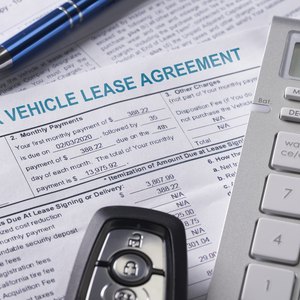
Leasing a car means that you face a decision every few years of what to do with your car at the end of each lease term. Perhaps you like having a new car every few years, so you trade in your leased car at the end of each lease. Or maybe you like the leased car that you have now and want to keep it. Which of these alternatives make sense financially?
Let's examine the terms of your car lease and see how they can affect your decision.
Steps to Take Before the End of a Car Lease
Review the terms of your lease contract three to four months before it ends. Look for the amount of the disposition fee and find the residual value, also called the buyout price. The disposition fee is the amount the dealership charges for reconditioning the car to get it ready for resale. Disposition fees can range up to $400.
The residual value is the amount you would pay if you want to purchase your car at the end of the lease term. If the market value of your car is higher than the residual value, then you have equity that you can apply on a new lease.
Leasing companies go to great analytical lengths to make sure the residual value is close to the market value of the car at the end of the lease to prevent the lessee from building up equity in the car. But this is not always the case, so it’s worth the effort to find the market value for your car and see if you have accumulated any equity.
Determine the market value of your car. This can be difficult to pin down, but one good source to get an indication of market value is CarMax. Be aware that a dealer is only going to offer you the wholesale price or auction price for your car, not the retail value that you will see advertised for sale.
Prepare the car for inspection before turning it in. Get it washed and have it detailed. Repair any small dings or dents. If you have more severe dents, it may be worth the expense to hire an outside company to make the repairs rather than paying the higher amounts that a dealer is likely to charge to make the same repairs.
Your Options at the End of a Car Lease
After getting your car in good condition, you have three options for your leased vehicle at the end of your lease. Let's look at each option to determine which one could be the best choice for your situation. The most desirable option is determined by the residual value from your lease, the market value of your car and its condition.
1. Return the Car and Walk Away
The first option is to simply turn in your leased car to the dealer and walk away. If you turn in your leased car before the end of its term, you have to pay very stiff early termination fees.
If you wait until the end of the lease, you pay the full amount of the disposition fee in addition to any fees for excessive wear and tear or for going over the mileage limits set by your lease. Sometimes this may be the best alternative.
Consider this example. Suppose the residual value stated in your lease is $18,000 and the best offer you've received for your car is $16,000. In this case, you would be better off to take the lease return option and pay the disposition fees, charges for wear and tear and any excess mileage charges and walk away from the lease. It doesn't make any sense to pay $18,000 for a car that is only worth $16,000.
Read More: How Does an Auto Lease Look on My Credit Report?
2. Trade the Car in for a New Lease
Your dealer may offer to discount the disposition fees if you agree to a new lease. The dealer will probably send you advertisements several months before the end of your lease that offer attractive terms if you lease a new car from them. Your dealer may even be willing to offer some concessions on excess mileage charges and excessive wear and tear on your car.
If you’ve taken very good care of your leased car, the market value may be worth more than the residual value set in the lease. If so, you have earned equity in your car that you can use like a trade-in and roll over into a new lease. You lose this equity if you decide to turn in the car and walk away.
3. Buy the Car
If you like your leased car, you may want to purchase it at the end of the lease term. However, this isn't always the best decision. It depends on the residual value stated in your lease, the market value of your car and any penalties you may be facing.
Let’s suppose the residual value for your car is $18,000, but you’ve taken your car to a dealer who is willing to pay $20,000 for your car. This means you can purchase the car from the leasing dealer for $18,000 and then sell it to the other dealer for $20,000, realizing a gain of $2,000. Now you have a check for $2,000 that you can apply to the purchase of another car or make a down payment on a new lease agreement.
Another reason to buy your leased car is if your car has excessive wear and tear or if you have exceeded the mileage limits stated in your lease. In this situation, you may be facing some heavy penalties. Some car lessors charge up to $0.25 for each mile over the limit stated in the lease. That means for each 1,000 miles you exceed the limit, you pay a penalty of $250. If you're a heavy driver, a few thousand miles can add up to a hefty charge.
You can avoid these additional costs by buying your car. Even if you don't have equity, as in the above example, it may still be cheaper to buy the car rather than paying the additional penalties.
You always have these three options at the end of each car lease. The best way to find your optimal choice is to do the math for each option.
References
- Autotrader: 5 Reasons Why You Should Buy Your Leased Car
- AARP: What to Do When Your Car Lease Ends
- CBS News: Car Lease Ending? You Have Options — and Could Even Make Money
- Credit Karma: Lease Buyout: What You Need to Know
- Consumer Financial Protection Bureau. "What Should I Know About the Differences Between Leasing and Buying a Vehicle?" Accessed April 12, 2020.
- Merriam-Webster. "Lease." Accessed April 12, 2020.
- AARP. "To Buy or Not To Buy." Accessed April 12, 2020.
- Consumer Financial Protection Bureau. "What is a Manufacturer Suggested Retail Price (MSRP)?" Accessed April 12, 2020.
- LeaseGuide.com. "Capitalized Cost – Cap Cost." Accessed April 12, 2020.
- Autotrader. "Leasing a Car: Can You Negotiate the Price?" Accessed April 12, 2020.
- Edmunds. "The 'Residual Value' of Leasing." Accessed April 12, 2020.
- Federal Reserve. "Keys to Vehicle Leasing: Future Value." Accessed April 12, 2020.
- LeaseGuide.com. "Money Factor—Explained." Accessed April 12, 2020.
- Federal Trade Commission. "Financing or Leasing a Car." April 12, 2020.
- Federal Reserve. "Keys to Vehicle Leasing: End-of-Lease Costs: Closed-End Leases." Accessed April 12, 2020.
Writer Bio
James Woodruff has been a management consultant to more than 1,000 small businesses. As a senior management consultant and owner, he used his technical expertise to conduct an analysis of a company's operational, financial and business management issues. James has been writing business and finance related topics for work.chron, bizfluent.com, smallbusiness.chron.com and e-commerce websites since 2007. He graduated from Georgia Tech with a Bachelor of Mechanical Engineering and received an MBA from Columbia University.

